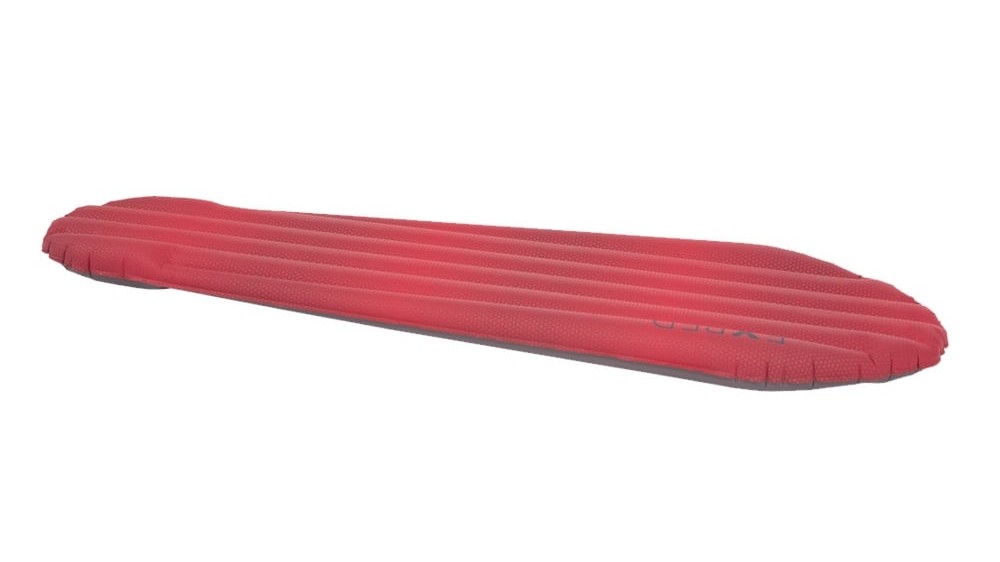Advnture Verdict
Delivering excellent warmth for weight, this is a technically advanced and superbly engineered lightweight insulated sleeping mat that excels in cold conditions.
Pros
- +
Very warm
- +
Lightweight and packable
- +
Non-slip surface and soft-touch fabric
- +
Raised edge baffles to help stop you sliding off
Cons
- -
Standard size is highly tapered
- -
Longitudinal baffles not as stable as other designs
You can trust Advnture
First impressions
The superbly-engineered Exped SynMat HL Winter M sleeping pad has plenty of considered features that set it apart from its competitors. At first glance, the vertical baffle design and tapered shape don’t look too unusual. But in fact, the two edge baffles are slightly oversized, a design feature that is intended to keep you securely in the middle of the mat all night long.
The face fabric is also a soft-touch, slightly fuzzy material, overlaid with a honeycomb grip pattern, further reducing the risk of slipping off the mat. It is also meticulously constructed, as the internal insulation is internally laminated to both upper and lower surfaces of the air-filled chambers for long-term durability.
- Want to browse other options? Explore the best sleeping pads here
- Learn how to choose a sleeping pad
- Got everything for your next adventure? Check our camping checklist
On paper, it will certainly appeal to winter campers and other cold-weather adventurers, as it delivers plenty of warmth, with a high R-value of 5.2. Yet in terms of both overall weight and pack size it is highly competitive – among the best in its class. So, if you are a cold sleeper or will be out and about in demanding conditions, it’s certainly an enticing option.
The pad is supplied with Exped’s ‘schnozzel’ pump sack, which allows for rapid, easy inflation. The bag can also double as a drybag or rucksack liner, increasing its usefulness and meaning its extra weight is worth carrying on the trail. This is one of our favourite features.
In the field
This pad has a low-profile valve design that sits discreetly out of the way, though the fact that it is placed on the underside of the mat makes it a little tricky to tweak the level of inflation.
However, we’re big fans of Exped’s schnozzle pump sack, which is one of the better systems for blowing up sleeping mats. Admittedly, it’s not quite as easy to use in the confined space of a tent as some others, but in the open air it works very effectively, especially when there’s a little wind to help fill the bag.
Overnight, we found the mat very comfortable, thanks to a plush thickness of 9cm, and we slept soundly. The longitudinal baffles feel a bit bouncy, particularly if you wriggle around a lot, but they do not collapse, offering good stability.
All the latest inspiration, tips and guides to help you plan your next Advnture!
We did slip off the mat a couples of time however, despite those enlarged edge rails and the grippy top surface. We put this down to the mat’s highly tapered cut, particularly at the hips. As such, we’d say it is best suited for slimmer builds – others might want to take a look at the Medium Wide (MW) or Long Wide (LW) versions, which offer additional space from shoulders to feet (albeit with a corresponding increase in weight and pack size).
On the other hand, the streamlined cut is a highly effective weight-saver, particularly for an insulated mat that is warm enough for winter camping in temperatures way below zero. In fact, few other four-season mats can compete in terms of overall warmth for weight, making this a stand-out option.
An outdoors writer and editor, Matt Jones has been testing kit in the field for nearly a decade. Having worked for both the Ramblers and the Scouts, he knows one or two things about walking and camping, and loves all things adventure, particularly long-distance backpacking, wild camping and climbing mountains – especially in Wales. He’s based in Snowdonia and last year thru-hiked the Cambrian Way, which runs for 298 miles from Cardiff to Conwy, with a total ascent of 73,700 feet – that’s nearly 2½ times the height of Everest. Follow Matt on Instagram and Twitter.


